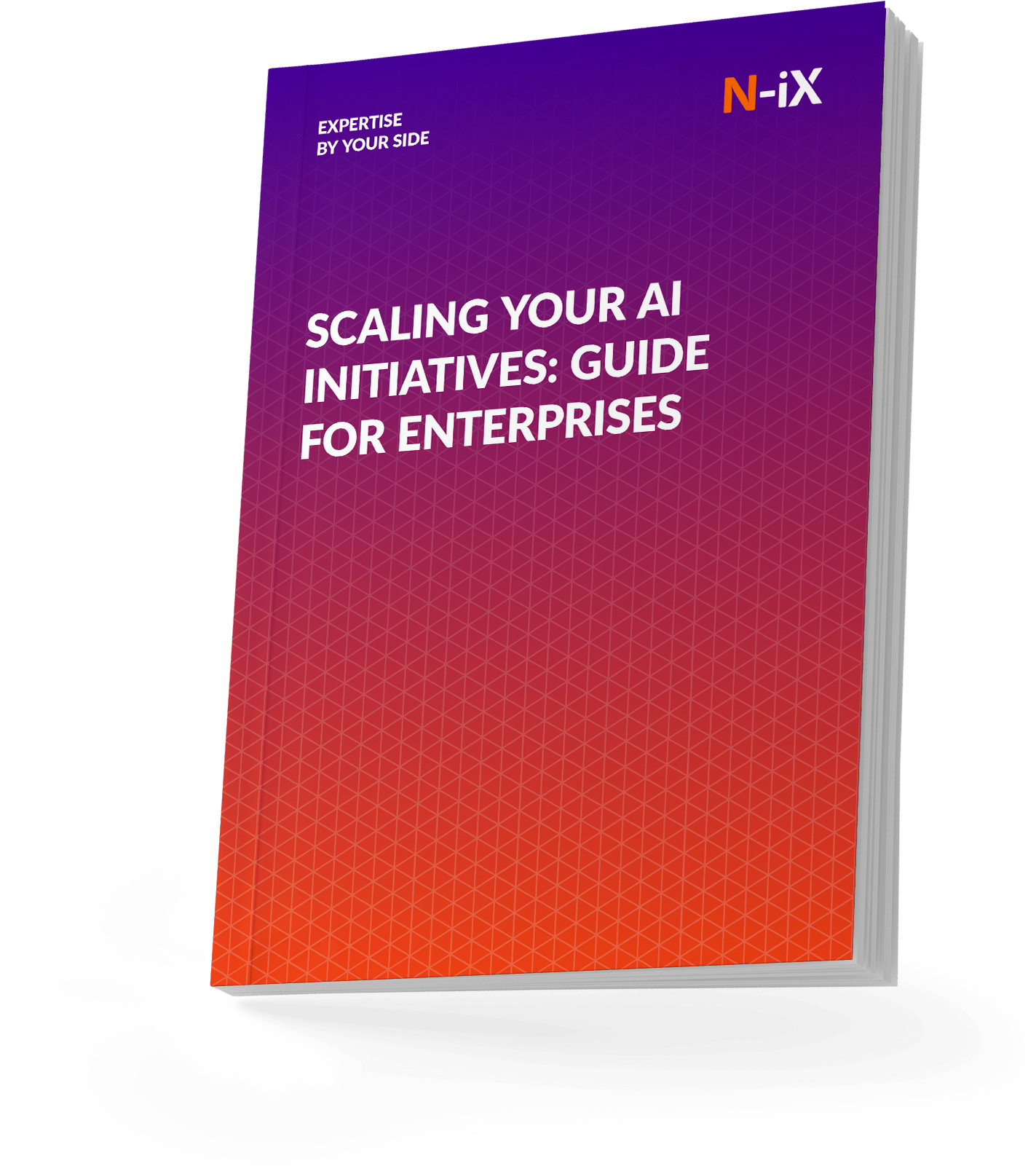The agriculture sector today faces a multitude of challenges, including rising labor costs, diminishing soil fertility, unpredictable weather conditions, and the need for precise management of resources like water, fertilizers, and pesticides. As traditional farming methods reach their limits, the need for innovative solutions becomes urgent. Artificial Intelligence has immense potential for tackling these and other challenges.
AI in agriculture allows farmers to improve yields on limited land holdings, optimize the use of resources, and reduce labor costs. However, most enterprises in the sector lack the tech expertise and resources for designing and implementing an effective AI strategy. As a software service provider that offers a wide scope of AI and ML development services as well as proven experience in agritech software development, we at N-iX would like to share some of the key applications of AI in agriculture, the technologies transforming modern farming, and essential guidelines on how to adopt them to drive maximum value.
Why should you implement AI in agriculture?
According to market.us, the global market for Artificial Intelligence in agriculture, valued at approximately $1.5B in 2023, is projected to reach $10.2B by 2032. This rapid expansion highlights AI’s transformative potential in the agricultural sector. AI enhances productivity, optimizes resource management, and promotes sustainability through various innovative solutions.

Boost food production
AI in farming increases crop yields by up to 30%. It provides access to real-time insights into soil conditions and crop health, enabling better-informed decisions. The data gained is combined with predictive analytics to assist in optimal planting and harvesting schedules, ensuring crops thrive under the best possible conditions.
Maximize land use efficiency
Through precision agriculture, AI ensures that every part of the field is used efficiently. Farmers can prevent wastage and enhance overall land productivity by tailoring the application of inputs like water and fertilizers to specific areas. Such an approach leads to better resource management and higher yields from the same amount of land. For example, John Deere is working with satellite partners to create geospatial maps that help farmers track productivity and crop performance more effectively.

Enhance climate resilience
AI in agriculture also empowers farmers to adapt to climate change by analyzing historical and current data to forecast weather patterns and climate impacts. For instance, tools like Climate FieldView help farmers understand the complex relationship between weather and crop health. These forecasts allow proactive adjustments, such as selecting resilient crop varieties and optimizing planting schedules to mitigate risks associated with adverse weather conditions.
Promote environmental sustainability
Precision agriculture promotes eco-friendly farming practices by optimizing input usage and minimizing ecological impact. Precision application of fertilizers and pesticides reduces runoff and pollution, while efficient water usage through AI-guided irrigation systems conserves water resources. Additionally, maintaining healthy soil through AI-powered monitoring promotes long-term sustainability. One example is Trimble's precision technology, which optimizes nutrient application, resulting in cost savings and environmental protection through targeted fertilizer distribution.
Reduce labor costs
While fully autonomous machines, such as AI-powered tractors and harvesters, are still under development, there are driverless tractors that are operated with supervised autonomy. Besides those, there are other technologies that perform highly precise tasks with minimal human intervention. For instance, John Deere introduced See & Spray Ultimate, a system that precisely targets weeds among corn, soybeans, and cotton using dual-product technology. Other examples are AI-enabled robots that manage repetitive tasks, such as weeding, allow continuous operation, and significantly lower labor expenses.
How does AI power precision agriculture?
According to the American Farm Bureau Federation, US agriculture would have required 100M more acres to achieve today's production levels if it operated with the methods used 30 years ago. This remarkable improvement highlights the efficiency gains driven by modern technologies, particularly precision agriculture, which optimizes resource use and maximizes crop yields.
The core idea of precision agriculture is to observe, measure, and respond to variability in crop state to maximize yield and resource efficiency. It significantly enhances farming operations by optimizing input use and ensuring crops receive a precise amount of the resources they need. Such use of AI in agriculture stands in contrast to traditional methods that treat entire fields uniformly, regardless of variations in soil quality, moisture levels, or plant health.
AI is a critical component of precision agriculture, driving advancements in several key areas:
- Data analysis: AI processes data from various sources, such as sensors, drones, and satellites. ML algorithms analyze this data to provide actionable insights for farmers.
- Predictive modeling: AI models predict outcomes like crop yields, pest outbreaks, and optimal harvest times, enabling proactive decision-making.
- Automation: Autonomous machinery and robotics are powered with AI to perform tasks with high precision, reducing labor costs and increasing efficiency.
To leverage the precision agriculture approach, AI has to be combined with the other supporting technologies.
- GPS and GIS provide precise location data, enabling site-specific management of fields.
- Remote sensing drones and satellites equipped with advanced sensors capture detailed images of crops, which are then analyzed to monitor health and detect issues.
- IoT sensors in fields collect real-time data on soil moisture, temperature, nutrient levels, and other environmental factors.
- Variable rate technology (VRT) allows for the variable application of inputs like water, fertilizers, and pesticides based on data-driven insights.
- Big Data analytics helps process and interpret the large volumes of data generated by modern farming technologies.
Discover more stats and trends in agriculture technology
Ten ways to apply AI in agriculture

1. Soil health monitoring
AI analyzes data from soil sensors to provide insights into pH levels, nutrient content, and moisture. The information from sensors for soil moisture measurement, like those provided by Delta-T Devices, enables farmers to make better-informed soil management and fertilization decisions, improving crop health and yield. Understanding the precise state of the soil in different areas of the field allows farmers to avoid overusing fertilizers.
2. Crop health monitoring
High-resolution images from AI-powered agriculture drones and satellites are analyzed to monitor crop health, identify nutrient deficiencies, and detect diseases. This information allows for early intervention and precise crop management, preventing minor issues from becoming significant problems. Other ways to monitor crop health exist, such as Plant Insights by Prospera, which turns irrigation pivots into crop health monitoring tools.
3. Precision farming systems
Variable rate technology applies fertilizers, pesticides, and water exactly where needed, based on real-time sensors and GPS data. For instance, advanced irrigation systems use AI to optimize water schedules based on data from soil moisture sensors, weather forecasts, and crop water needs. This targeted approach ensures optimal resource use, minimizes waste, enhances crop yields, and overall increases farm profitability.
4. Weed and pest control
AI-driven robots and systems identify and remove weeds accurately, significantly reducing the need for chemical herbicides. Early detection of pest infestations through Computer Vision and image recognition allows for targeted and effective pest control measures, protecting crops and reducing the use of pesticides.
5. Predictive analytics tools
AI models analyze historical data, weather patterns, and soil conditions to forecast crop yields and identify potential risks. These tools help farmers plan planting and harvesting schedules more effectively, manage resources efficiently, and mitigate risks associated with pests, diseases, and adverse weather conditions. Predictive analytics enable proactive decision-making, enhancing farm productivity and resilience.
6. Autonomous machinery
Automated machinery, including semi-autonomous tractors and harvesters, can operate continuously, reducing the need for manual labor and cutting costs, especially during peak seasons. Besides plowing and planting, automation extends to precise irrigation systems, which ensure optimal water usage, AI-driven drones that monitor crop health and deliver targeted treatments, weeding machines, and precision sprayers that apply herbicides and pesticides only where needed. Another solution is still in development. It is currently an announcement by John Deere, a company that creates its fully autonomous tractor, designed to work independently around the clock, allowing farmers to focus on other critical tasks while the tractor handles tillage and other operations.
7. Livestock health management
Sensors and AI-powered cameras monitor livestock health, detecting signs of illness, stress, or injury early. This practice enables timely interventions, reduces livestock mortality, and improves animal welfare. Enhanced livestock management improves productivity since healthy animals have better growth rates, higher milk production, and improved reproductive performance. Moreover, early disease detection and timely intervention can reduce the need for emergency veterinary care, which is often more expensive than preventive measures.
8. Automated feeding systems
AI in agriculture facilities controls automated feeding systems to deliver the right food to livestock based on individual needs. This precision feeding improves feed efficiency, reduces waste, and enhances animal health and productivity. Optimized feeding strategies also contribute to better growth rates and overall farm profitability.
9. Supply chain optimization
Market trends and consumer behavior analysis play a crucial role in predicting the demand for agricultural products. This forecasting aids in production planning, optimizes storage conditions, and ensures produce reaches markets in the best condition. Effective supply chain management reduces waste, improves logistics, and increases customer satisfaction. According to McKinsey, companies that adopt advanced analytics have achieved significant cost reductions of up to 10% in their supply chains and inventory cuts of as much as 25%.
10. Farm management software
AI-powered farm management software integrates data from various sources to comprehensively view farm operations. This software supports better decision-making, enhances productivity, and assists with financial planning by analyzing costs and revenues. Comprehensive farm management leads to more efficient and profitable farming operations.
Learn how to implement Big Data in agriculture
Learn how to scale AI initiatives across your enterprise effectively – get the guide now!


Success!

An agriculture enterprise’s success story with N-iX
Our partner, an agri-services group, provides integrated agronomy services offering advanced technology and expert advice for better farming practices. The company contacted N-iX to build data-driven crop management solutions that would enable farmers to better monitor crop health, manage nutrients, and predict yields accurately.
N-iX has developed a suite of software solutions for both basic and complex agricultural tasks. The results of our cooperation include a responsive web application connecting agronomists and farmers, a mobile and web application for field data management and financial transactions, and a web-based app integrating satellite imagery for crop monitoring.
Our partnership has yielded significant value for businesses and farmers. Here are some key highlights:
- Structured access to satellite data: Our experts enabled efficient organization and access to vast amounts of satellite data (terabytes daily). This solution empowers users with NVDI imagery for data-driven decision-making, allowing them to track crop health, identify potential issues, and optimize resource allocation.
- Smart nutrient management: The solutions incorporate soil analysis to recommend precise nutrient distribution plans, resulting in cost reduction and sustainable use. The app factors delivery costs and suggests optimal choices to maximize farmer profits.
- Yield prediction and adjustments: Our contribution includes advanced prediction models that combine NVDI imagery, soil data, weather forecasts, and farmer-provided information. This comprehensive approach allows users to generate accurate yield estimates and adjust nutrient application as needed to achieve optimal results.
Wrap up
The integration of AI in agriculture marks a revolutionary shift in farming practices. AI-driven solutions offer a comprehensive approach to modern agricultural challenges. From real-time soil monitoring to predictive analytics for better planting schedules, AI enables farmers to make data-driven decisions that improve productivity, reduce waste, and improve logistics. The rapid expansion of the AI in agriculture market underscores the sector's potential and the significant benefits it brings to farmers worldwide.
N-iX stands ready to help you harness the power of AI in agriculture for your projects. Our end-to-end AI consulting and development services are designed to support your agriculture initiatives from ideation and strategy development to implementation and ongoing maintenance. With 200 AI and data experts as well as over 2,400 software engineers globally, we leverage the latest advancements in AI, ML, IoT, and Big Data Analytics to develop innovative solutions designed for your long-term success.




